Christopher Nolan’s new epic, Interstellar, is a magnificent achievement technically but falls a bit short in terms of story and character development. It’s an intriguing mix of science fact and fiction that attempts to turn a potential end of the world scenario with a phoenix-like rise from the ashes story. It spends a lot of time thinking and paying homage to Kubrick, but falls short with plot points that don’t add up and maybe one-and-a-half characters that are at all developed.
Matthew McConaughey shines as Cooper, an engineer turned farmer by necessity and Mackenzie Foy shines as his intelligent, earnest, determined young daughter, Murph. Otherwise, there are no characters we can really care about – which makes all the cool science stuff less relatable.
The earth is dying – tables are set with dishes placed face down because of the dust that settles between the time the table is set and the meal is served. Dust storms are so intense they rise even when it’s raining.
Cooper is raising his children – son Tom (Timothée Chalamet) and daughter Murph – on a farm, growing corn (the only crop that is still able to flourish). The former NASA pilot is helped by his father-in-law, Donald (John Lithgow).
A series of anomalous occurrences finds Cooper and hitchhiking Murph discovering the secret NASA – the official organization having been disbanded because we couldn’t afford to be looking at the stars – even textbooks have been rewritten to say that the moon landing was a fraud created to force the Soviet Union into bankruptcy (a bit of retconning that showcases Cooper’s pride in his daughter – and one of the few genuinely witty moments in the film).
NASA has been planning an interstellar mission through a recently appeared wormhole just beyond Saturn – and enlists Cooper to pilot it. Near light speeds would mean he wouldn’t return for decades. While the mission is underway, Professor Brand (Michael Caine) will be finishing work on a theory that ties times, space and gravity in a way that will, hopefully, make it possible to save humanity by moving to another world.
The first half of Interstellar sets up the film’s premise, the relationships that exist and the scientific speculation – based on input from leading theoretical physicist Kip Thorne – and it is frequently completely absorbing. We meet the mission team – Brand’s daughter Amelia (Anne Hathaway), scientist/co-pilot Doyle (Wes Bentley), astrophysicist Romilly (David Gyasi) and TARS (voiced by Bill Irwin), a mobile computer/robot that looks a lot like Kubrick’s obelisk when not in motion.
There are three possible new homes for humanity and the mission is to find the one that will work best. Obstacles arise – including a new character who claims to be hate being alone yet does everything possible to remain so.
Meanwhile back on Earth, the grown Murph (Jessica Chastain) has become Brand’s protégé and is working with him at NASA. She has a contentious relationship with her brother (Casey Affleck) that provides another obstacle to the mission in a unique way.
With Interstellar, Nolan and his brother/co-writer Jonathan, tackle the problem of the results of global warming without actually naming the process but very clearly showing one worst-case scenario resulting from it. They look at science in a way that recalls the hard science sci-fi of Arthur C. Clark to such a degree that even Hans Zimmer’s score echoes the music of 2001: A Space Odyssey. They even explore the way that love – a clearly demonstrable phenomenon that doesn’t quite line up with all its scientific attempts at explaining – can affect physics.
In terms of ideas, Interstellar is big; in terms of its effects, it is spectacular – as you watch, bear in mind that virtually everything you see was shot in camera.
In terms of story and character development, though, Interstellar falls just a bit short. Brand is the mentor role that Caine can play in his sleep; Donald is the wise father that Cooper would like to be; Tom is the dutiful son; Romilly is the thoughtful one; Doyle is the (slightly fiery male), etc.
Only Cooper gets a full arc, changing and growing throughout the film. Even Murph’s development stops after Cooper leaves Earth – though the grown Murph is, essentially no different, scientific achievement aside, the second half of the movie does get TARS. The computer/robot character comes across as a less demented HAL 9000 crossed with a certain Star Wars protocol droid – listing facets of his programming gives us another genuinely witty few moments and his decisions play up those levels nicely.
Overall, Interstellar is a very entertaining film – though definitely not Nolan’s best. He does a good job of keeping the science from becoming boring and his visual sense has never been more breathtaking. It’s in trying to bring love into the equation that he falls short.
Kubrick’s 2001 is a classic because of its ideas – he didn’t particularly care about plot or his characters. Nolan tries to create a film of ideas and emotions other than just curiosity and pure awe. In trying to emulate Kubrick, he has created a great looking, thoughtful – even provocative – film. In trying to fuse ideas with emotions and plot, he falls just a bit short. The result is a very, very good film – but not a great one.
Final Grade: B+
Photo courtesy of Paramount Pictures
